| Author |
Message |
Luka Borscak

|
 Posted: Wed 26 Sep, 2012 9:41 am Post subject: One more thread about use of the twohanders and push of pike Posted: Wed 26 Sep, 2012 9:41 am Post subject: One more thread about use of the twohanders and push of pike |
 |
|
Yes, I know this topic has been discussed many times, but it's fascinating! I believe there is still a lot to discuss about it...  First, let me start with posting these few pictures collected on myArmoury and other forums and webpages: First, let me start with posting these few pictures collected on myArmoury and other forums and webpages:
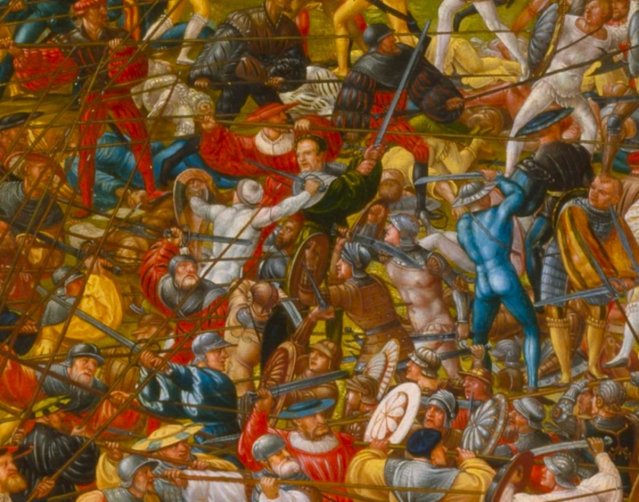
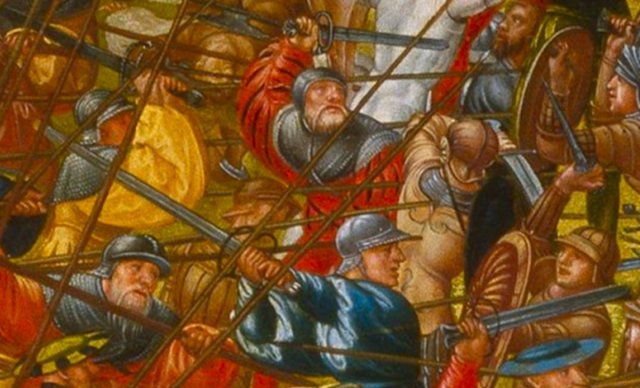
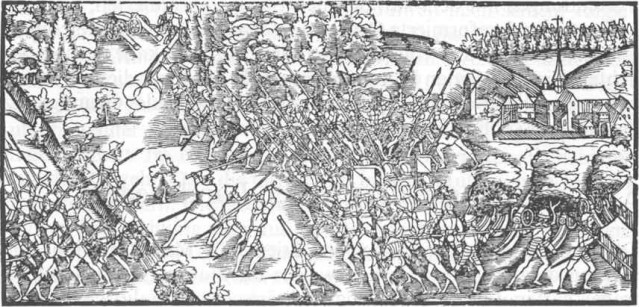
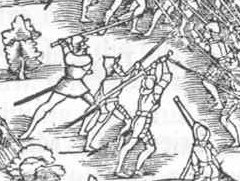

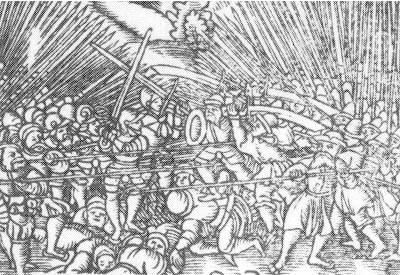
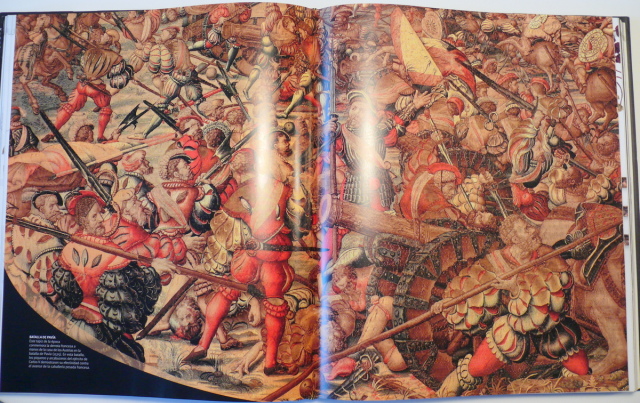
Watching these pictures and observing what landsknechts and Swiss reisläufer wore at their belts or in hands on many contemporary pictures, I realized many of them had rather long swords and they fought with them when push of pike turned into a chaotic melee. Even katzbalgers, although rather short, are primarily cutting swords and as such require some area to be wielded effectively. So, my theory is that when two pike blocks met, the first ranks just couldn't fight with pikes for too long, rear ranks pushing forward, pikes being hit with other pikes and various other weapons, pikes breaking, stucking in enemy bodies etc... Than the melee begins and it's not too crowded to use various cutting weapons: katzbalgers, hand and a half swords, kriegmessers, two handers... And rear ranks which are still far enough from the enemy might still try to poke enemies with their pikes but they attack with their pikes enemy's secondary ranks, not engaged in that chaotic melee of the first ranks too close for pikes. Does that sound plausible? I realize pikeman sometimes stood and didn't push forward and just "fenced" and stabbed with pikes but I doubt battle between two pike blocks can be decided like that...
Second thing I noticed is that in all pictures depicting action, battle, two handed swordsmen wield two handers without parrierhaken! I realize fully developed characteristic landsknecht zweihander, huge, with narrow ricasso and parierhaken and swirls on crossguard developed after two handers period of greatest use on the battlefield, but parierhaken seem like a very useful detail and not something that would take long to develope and be present more often on bearing swords that battle swords... When did parierhaken first appeared? Also, katzbalger hilted two handers seem to be more popular than I thought... Why are there so few surviving examples, I wonder...
Lat thing, in one of the pictures you can see three soldiers detached from the pike blocks, attacking enemy block and two of them, on the right and left, have a large two hander. This is the 1548 picture of battle of Kappel, 1531. Nothing spectacular hear except that two handers are not depicted in a melee but in a skirmish-mode, attacking from the flank in a small group... Again, no parrierhaken on the two hander's blades...
Please, feel free to comment and post pictures of two handers in action, never enough of those... 
|
|
  |
 |
|
David Gaál
|
 Posted: Wed 26 Sep, 2012 12:36 pm Post subject: Posted: Wed 26 Sep, 2012 12:36 pm Post subject: |
 |
|
Hello Luka!
I would like to ask from where the first picture is: manuscript or painting? From where could I download the whole picture?
Thanks
Dávid
Dávid
http://energie-fenster.at/
|
|
   |
 |
Luka Borscak

|
|
  |
 |
Luka Borscak

|
 Posted: Sat 29 Sep, 2012 8:00 am Post subject: Posted: Sat 29 Sep, 2012 8:00 am Post subject: |
 |
|
|
Nobody anything? Any thoughts on the figure eight guards on two handers? Are they at a disadvantage when parrying? Is long, straight or curved towards the blade cross better to parry with? How much advantage parrierhaken offer? If any unless you are holding the ricasso and not the grip?
|
|
  |
 |
|
Timo Nieminen
|
 Posted: Sat 29 Sep, 2012 2:32 pm Post subject: Posted: Sat 29 Sep, 2012 2:32 pm Post subject: |
 |
|
The figure 8 guards (or S-guards, if the "8" isn't closed) are fashion, basically Katzbalger guards. But I think they'd work well enough. But I think a long guard with side-rings will work better. Curved towards the blade even better. But long guards and especially curved-towards-blade guards will get in your own way more.
Given that (optimally) you don't block with the guard, as long as you have enough to stop a blade sliding down onto your hands, you have "enough". But a long guard means that when your opponent wants to disengage and come around your grip to hit you, they have further to go. Curved-towards-blade means that they might have to pull back too.
This will matter most when fighting against polearms (or other two-handers, maybe).
I don't think Parierhaken will do much unless you're half-swording (i.e., holding by the ricasso). Then you'll appreciate them especially if you don't have good gauntlets. They can be a bit of a proverbial "double edged sword", since your opponent can make some use of them to push your blade around.
I haven't done enough in-fighting with two-handers, so the above is provisional thoughts, rather than firm conclusions.
"In addition to being efficient, all pole arms were quite nice to look at." - Cherney Berg, A hideous history of weapons, Collier 1963.
|
|
   |
 |
|
Joshua Spencer
Location: Plano, TX Joined: 08 Aug 2012
Posts: 10
|
 Posted: Sat 29 Sep, 2012 4:32 pm Post subject: Posted: Sat 29 Sep, 2012 4:32 pm Post subject: |
 |
|
Different nationalities and different groups within them had various ways of fighting in formation and weapon preferences so there isn't exactly a perfect answer to what could be going on in the paintings. The tactic I am most a fan of is to have alternating layers of pikemen, dopplesoldners, and gunners. The gunners form the first rank and will provide an opening volley where they will then fallback to the flanks and rear of the formation to prevent attacks from those sides. Next comes your layers of dopplesoldners with their halbers, zweihanders, and "fancy" weapons and your pikemen. The pikemen form your igel or hedgehog with varying length and positioned pikes. The dopplesoldners will provide close in support by protecting the pikemen and taking advantage of gaps created. Now there seems to be big debate on the cutting of pike heads and what not, but my personal belief is that if you can't kill the man but can destroy his weapon why wouldn't you? Now its safe to assume at this point things will begin to degenerate and the formations will be begin to break and spread into a wall. This is where those gunners pop back up on the offensive. Being on the outside of the formation they are free to fire upon the flanks of the opposing formation especially as that wall start to form. After the shots are fired there is a wash, rinse, and repeat of their positioning.
As far as the zweihander is specifically concerned, I wouldn't worry too much about the lack o' haken. They are a relatively small detail and may have been left out. A lot of the guards I am seeing aren't much more than a simple black line at best. It may also not have been that feihnlein's preference to use swords with them. From being in the army I know that if one person really likes the way a piece of equipment is set up a lot of people will follow that example. Landsknechts and Reislaufer were also rather trendy folks, Landsknecht probably the worse of the two, so at the time of the painting, or battle it self, it may not have been trendy to have the 'haken on a sword.
|
|
   |
 |
Daniel Wallace

Location: Pennsylvania USA Joined: 07 Aug 2011
Posts: 580
|
 Posted: Sat 29 Sep, 2012 4:51 pm Post subject: Posted: Sat 29 Sep, 2012 4:51 pm Post subject: |
 |
|
it's hard to date when Parierhaken developed onto two handers. the ones i was tracking down were dated to 1530 or around that time period. i've read a few articles that Parierhaken are simply an additive to protect the fingers, much like how quillon rings do. why their on some example and not others is a mystery for me.
i believe the idea of the two handers skirmishing is a rather decent idea. this is not a formation weapon, in my theories of the sword they can't be used in formation combat, their range of motion is far too great. in my opinion, taking any non formation unit against a unit in formation will always favor the unit in formation.
fighting in tight squeezed ranks you would probably fall back to your long knife of short sword of sorts (every culture that seems to have used the two hander also seems to have a heavy short sword associated with being in fashion at the same time.) i think the descriptions of the swords being used to break pike formations may be accurate - but we also might be looking at it in a different way. to charge at a pike formation - i don't think the sword will be to any advantage however if the pike formation is already engaged, and is flanked by two handers, now you may have a different story.
the only written work that i've been able to look into is the Memorial - which is dependant on the Montante, but the rules probably apply to the western german styled sword as well. throughout the work, the strength of the two handed sword is isn't ability to adapt to other weapons, and every stroke seems to be centered on 'staying' the attackers blade away, by means of deflection, not using any push factor but its wide swirling motions. to do this, you don't really need Parierhaken.
theres also the mention of half swording a two hander, but as for the Memorial there are no descriptions of half swording. but anyone who has learned long sword will have a tendency to want to apply what they already know.
after reading the memorial, you get an understanding that two handers are an elite weapon, they can fend off several attackers at the same time, and be applied to fight against any weapon. but its fault lies in its individuality and inability to be applied to formation combat. at least from my understandings 
|
|
  |
 |
Luka Borscak

|
 Posted: Tue 09 Oct, 2012 7:31 am Post subject: Posted: Tue 09 Oct, 2012 7:31 am Post subject: |
 |
|
Thanks for the comments guys. Lately I'm constantly searching info about pike block warfare and two handers role in it and I think there are two ways to use them.
The first is to have small groups of two handed swordsmen behind the first few ranks of pikes so that when at one point of the front line the line is broken (either yours or enemy line) and pikes are dropped and short weapons are used in a melee, the two handed swordsmen can pass forward and reinforce that part of line or help to further penetrate and destroy that part of enemy line.
The second is to have small groups of two handed swordsmen also behind first few ranks of pikes but grouped on the flanks so that when two pike blocks are engaged head on they can get out of formation and attack the enemy pike block from flanks and try to make damage there which could make the enemy formation panic and break.
Also I believe there are two groups of two handed swords. Swords for the first situation, stepping into a melee when yours or enemy's formation is crumbling and you either have to save your line or help destroy the enemy's. These swords are I believe shorter, may often have no parrierhaken and are often rather broad and similar in blades to earlier XIIIa or XX blades.
The other group for flank skirmishing is more specific two hander, bigger (since you have more space to use it in a skirmish mode), more often have parrierhaken and have longer grips and blades narrower but of cross sections more suitable for stiffing up the blade (hexagonal, flattened diamond). These are basically the famous landsknecht zweihanders with their very specific look but well balanced and not too big, heavy or too ornate for fighting.
(Some specimen of course fall somewhere between with their characteristics and may be used for both situations well enough.)
Of course, this is only speculation based on period woodcuts, manuscripts and paintings of landsknechts, reisläufer and battles, and pictures from museums or private collections of surviving two handed swords. Reenactment experiences are taken in consideration also of course, but bearing in mind their shortcomings.
|
|
  |
 |
Daniel Wallace

Location: Pennsylvania USA Joined: 07 Aug 2011
Posts: 580
|
 Posted: Tue 09 Oct, 2012 9:20 am Post subject: Posted: Tue 09 Oct, 2012 9:20 am Post subject: |
 |
|
one thing i've seemed fit to counter is the idea that these two handers were used to cut the heads from the pikes. i believe this to be nearly impossible if engaged in frontal combat. the pike is going to wiggle more than break, what may be plausible, engaging the pike from the flank instead of head on and possibly pinning it to the ground with a downward stroke giving the pike no where to move and then possibly the downward cut would cut the pike.
another idea i had involves the flamberge styled blade. a straight blade would have a tendency to deflect a pike when used the ways stated in the memorial, but would a flamberge styled blade be possible to bit into a pike haft better almost like a saw blade?
|
|
  |
 |
Luka Borscak

|
 Posted: Tue 09 Oct, 2012 9:53 am Post subject: Posted: Tue 09 Oct, 2012 9:53 am Post subject: |
 |
|
|
I haven't included cutting off pike heads because if it is possible or not, too much emphases has been put on that. Cutting the pike requires (if it's possible) a lot of energy and I don't think experienced swordsmen would focus so much on that. And in my theories swordsmen would never attack pikes head on. If pikes are dropped he doesn't have to worry about them and if he attacks pikeman from flank, out of formation, he would achieve nothing cutting of pike heads, he must just displace pike to reach the pikeman, there are no pikeman of his own behind him to take advantage of anything he does, he must make the damage on his own and that damage must be casualties, not just broken pikes. And in a flanking attack, two handers first must defeat enemy skirmishers probably present there to guard flanks, only then two handers can charge the pike flanks.
|
|
  |
 |
|
Timo Nieminen
|
 Posted: Tue 09 Oct, 2012 1:54 pm Post subject: Posted: Tue 09 Oct, 2012 1:54 pm Post subject: |
 |
|
| Luka Borscak wrote: | | Thanks for the comments guys. Lately I'm constantly searching info about pike block warfare and two handers role in it and I think there are two ways to use them. |
A third way to use them: Deploy as a screen on the flank of pike blocks, defensively, to protect the pike block from flank attack. The reputation of the two-handed sword as good for one-against-many suggest this kind of defensive deployment might have been common. Of course, we have this also for guarding standards/standard-bearers. (They could go and attack as well, and then that's your second way. But the main purpose might have been defensive.)
In a book on Scottish-English wars ("Border Fury"), I read that this was the Scottish deployment (i.e., on the flanks) at Flodden, based on Continental practice. No quotes from primary sources on this, or a specific reference for this particular fact given in the book, but perhaps there is something useful out there.
"In addition to being efficient, all pole arms were quite nice to look at." - Cherney Berg, A hideous history of weapons, Collier 1963.
|
|
   |
 |
Daniel Staberg

|
 Posted: Tue 09 Oct, 2012 5:06 pm Post subject: Posted: Tue 09 Oct, 2012 5:06 pm Post subject: |
 |
|
There is written evidence of how the men armed with twohanded swords were used, it is just a matter of taking the time to decode the old German handwriting or fraktur print.
So far I have yet to find evidence of them being deployed anywhere but deep inside the pike square where they were tasked with guarding the standards.
The 1536/1537 Trewer Rath envisons a 21 ranks deep formation
| Quote: | (Each rank is 13 files wide)
1-4th rank: "Doppelsöldner"
5th rank: halberdiers
6-7th rank: "Mittelsöldner"
8-10th rank: "gemeinen söldner"
11-13th rank: "Führern, Furirern, Waybeln und Schlachtschwerter" together with the two ensigns
14-18th rank: "gemeiner söldner"
19th rank: "knebelspeiss"
20-21st rank: Doppelsöldner
The Hauptmann stod in the middle of the 1st rank while the Leutnant stod in the last rank.
On each side of the men with pikes, halberds and other melee weapons stod 23 ranks of men with firearms, each rank was 5 files wide. The first 4 ranks were made up of "doppel-schützen" i.e men armed with heavier firearms such as the musket or even heavier doppelhaken. |
Erhard Schön provides an illustrated example of what the role of the men with "schlachtschwerter" played in the unit
http://i277.photobucket.com/albums/kk50/Dstab...parten.jpg
"There is nothing more hazardous than to venture a battle. One can lose it
by a thousand unforseen circumstances, even when one has thorougly taken all
precautions that the most perfect military skill allows for."
-Fieldmarshal Lennart Torstensson.
|
|
  |
 |
Luka Borscak

|
 Posted: Wed 10 Oct, 2012 4:17 am Post subject: Posted: Wed 10 Oct, 2012 4:17 am Post subject: |
 |
|
Daniel, based on that, do you think pictorial evidence is mostly artistic licence and not reliable? What about Paulus Jovius account of Swiss men with two handers stepping out of formation and attacking enemy pike block (probably from flanks)?
I think the fact their place was deep inside the formation do not tell us if they moved during the battle according to situation...
|
|
  |
 |
Daniel Wallace

Location: Pennsylvania USA Joined: 07 Aug 2011
Posts: 580
|
 Posted: Wed 10 Oct, 2012 9:26 am Post subject: Posted: Wed 10 Oct, 2012 9:26 am Post subject: |
 |
|
one thing that was just pointed out that i have had a tendency to lean to is their role as a defensive weapon more than offensive. the memorial does not point out that the iberian two hander was a sword of war - from reading it you get the notion that it had more of a protective role. there were discussions before about their role as a front line weapon but i'm only touching on discussions made about the iberian sword and style vs what mr Staberg's german findings.
to be deployed so deeply in the ranks, you could suggest that a devastated pike block taking heavy casualties turns to run and all of a sudden the two handers are acting like a rear guard? that may be a little out there because if all your buddies are running, your probably going to run too. but, two handers were an elite weapon, given to the best of the best. like your graduated with honors you started out with as pikeman, moved to a halberdier, and now you've been promoted to two hander. and if i'm not mistaken are not the more experienced solders farther back in the ranks or is that just something roman that i'm remembering?
artists are always at liberty to show what is exciting - but how many times have we found out that the art work is accurate.
|
|
  |
 |
|
Matthew P. Adams
|
 Posted: Wed 10 Oct, 2012 9:35 am Post subject: Posted: Wed 10 Oct, 2012 9:35 am Post subject: |
 |
|
Is there any historical reference to grasping the ricasso? I haven't seen anything myself, and any depiction of half swording that I have seen, the blade is grasped towards the middle. I don't think they were used that way, but I'm open to being wrong.
"We do not rise to the level of our expectations. We fall to the level of our training" Archilochus, Greek Soldier, Poet, c. 650 BC
|
|
  |
 |
Luka Borscak

|
 Posted: Wed 10 Oct, 2012 2:13 pm Post subject: Posted: Wed 10 Oct, 2012 2:13 pm Post subject: |
 |
|
Matthew, I have also never seen evidence of gripping the ricasso of a twohander.  About its defensive role, I would agree with you but I also don't think we can discard artwork as easily... About its defensive role, I would agree with you but I also don't think we can discard artwork as easily...
|
|
  |
 |
Daniel Staberg

|
 Posted: Wed 10 Oct, 2012 3:30 pm Post subject: Posted: Wed 10 Oct, 2012 3:30 pm Post subject: |
 |
|
| Luka Borscak wrote: | Daniel, based on that, do you think pictorial evidence is mostly artistic licence and not reliable? What about Paulus Jovius account of Swiss men with two handers stepping out of formation and attacking enemy pike block (probably from flanks)?
I think the fact their place was deep inside the formation do not tell us if they moved during the battle according to situation... |
Wether artwork is reliable or not depends on a lot of factors, a painting may offer valuable information about clothes and equipment while at the same time being unreliable with regards to the historical event it supposedly shows.
Pieter Snayers is rightly regarded as the foremost battle painter of the 30-Years War period, his paintings provide a very realistic portrayal of soldiers in the 17th Century. But as a source for military formations and battle deployments his paintings have a very varied value, some are good others misleading because Snayers tended to use artistic licence and for example often painted infantry units too deep, with too many pikemen and too closely together simply because this looked good and made it possible to fit the battle on to the canvas. Other paintings are much more accurate as he painted them for a man with great experience of the battle depicted and who clearly supplied Snayers with accurated information. (A good example of this is his painting of the battle of Lutzen made for Piccolomini who saw extensive action in that battle)
You have to use artwork carefully and verify it using other sources such as preserved items or written sources. You also have to look at who the painter was, what the painting is meant to depict and what experiences he had of the activity the painting is showing. Is he using artistic licence or artistic conventions and so on?
Drawings by men with active military experience such as Paul Dolnstein or Urs Graf have a greater value as evidence than those made by an painter with no experience of war or military men at all. A drawing made for a military manual such as Fronspergers "Kriegsbuch" has greater value than an allegorical print made to illustrate the struggel between Protestants & Catholics. And so on.
And even the best of images can not replace the written sources when it comes to complex things like military tactics, at best they can support and visualise the information found in the written sources.
Since the Schlachtschwerter were expressly used to protect the ensigns and the flags they carried it is unlikely that they were use for flanking movements and similar actions. If a commander desired to carry out such actions the halberdiers would be a superior choice given that their weapons were effective in a wider range of situations. The twohanded sword was a specialist weapon with a much more narrow role.
With regards to Jovius what battle is he describing? Do you have the origianl quote available?
It sounds to me like a description of the Swiss at the battle of Novara 1513 where such an action to place but the eyewitnesses such as Fleuranges (Robert III de la Marck) expressly say that it was done by halberdiers.
"There is nothing more hazardous than to venture a battle. One can lose it
by a thousand unforseen circumstances, even when one has thorougly taken all
precautions that the most perfect military skill allows for."
-Fieldmarshal Lennart Torstensson.
|
|
  |
 |
|
Jon Pellett
Location: Kamloops, BC, Canada Joined: 01 May 2007
Posts: 14
|
 Posted: Wed 10 Oct, 2012 5:59 pm Post subject: Posted: Wed 10 Oct, 2012 5:59 pm Post subject: |
 |
|
| Luka Borscak wrote: | Matthew, I have also never seen evidence of gripping the ricasso of a twohander.  About its defensive role, I would agree with you but I also don't think we can discard artwork as easily... About its defensive role, I would agree with you but I also don't think we can discard artwork as easily... |

Marozzo recommends this grip ("with your right hand between the big hilt and the little hilt") for going up against various polearms - but not bills, because your hand is too exposed.
|
|
  |
 |
Benjamin H. Abbott

|
 Posted: Wed 10 Oct, 2012 6:27 pm Post subject: Re: One more thread about use of the twohanders and push of Posted: Wed 10 Oct, 2012 6:27 pm Post subject: Re: One more thread about use of the twohanders and push of |
 |
|
| Luka Borscak wrote: | | Even katzbalgers, although rather short, are primarily cutting swords and as such require some area to be wielded effectively. |
I'm skeptical that cutting requires more area than thrusting. Sir John Smythe recommended keeping halberd length at six feet or below and having halberds that could cut effectively because of the difficulties of thrusting with longer halberds in the press. He wrote that such short halberds never interfered with each other when employed properly in formation. On the other hand, one sixteenth-century military writer claimed that the press in contests between pike blocks often got so tight that only daggers functioned.
| Quote: | | So, my theory is that when two pike blocks met, the first ranks just couldn't fight with pikes for too long, rear ranks pushing forward, pikes being hit with other pikes and various other weapons, pikes breaking, stucking in enemy bodies etc... Than the melee begins and it's not too crowded to use various cutting weapons: katzbalgers, hand and a half swords, kriegmessers, two handers... |
Smythe and others write about this explicitly. See here for relevant quotations. Fourquevoux and Smythe both expected halberdiers to fight in the press, so presumably men with two-handed swords could do the same.
| Quote: | | And rear ranks which are still far enough from the enemy might still try to poke enemies with their pikes but they attack with their pikes enemy's secondary ranks, not engaged in that chaotic melee of the first ranks too close for pikes. |
Smythe expressed doubts about efficacy of thrusting over the heads of friendly soldiers. His description of pike-on-pike combat emphasizes how easily everything becomes a tangled mess of shafts.
| Luka Borscak wrote: | | Cutting the pike requires (if it's possible) a lot of energy and I don't think experienced swordsmen would focus so much on that. |
Fouquevaux wrote about targetiers cutting off the heads of pikes with their single-handed swords. He suggested sending such troops - also armed with grenades - front front of friendly pikemen against another pike block. I've read that armored men with two-handed swords performed a similar role in German armies, though this is contested. However, di Grassi described how to cut through pikes with a partisan, halberd, or bill. If you can do it with a single-handed sword and you can do it with a polearm, I don't see why you couldn't do it with a two-handed sword.
|
|
  |
 |
|
Nicholas A. Gaese
Location: Montreal, Quebec, Canada Joined: 06 Aug 2007
Posts: 100
|
 Posted: Wed 10 Oct, 2012 9:50 pm Post subject: Posted: Wed 10 Oct, 2012 9:50 pm Post subject: |
 |
|
Hey Daniel,
I completely agree that art can vary in terms of quality of the depiction, and can pale in importance to written sources. However, even sources like Der Trewer Rath is not as accurate as a muster call, it was an envisionment of how military thinkers thought formations should be assembled. That said, it does give some numbers and names of formations and their captains. One of the rare examples I believe you mentioned previously was Wintzenberger, with his Fähnlein of 300 men, 14 of whom were doppelsöldner with harness and schlachtschwerter. A small number to be sure, but its there all the same. We can also use the imperial regulation of 1570, which figured out of 400 men, 50 armed with battle swords and polearms were to guard the standard. To me that sounds like a lot of guys for guard duty, especially since only 150 men would be armed with pikes....The rest had guns if I remember right.
Well all these sources show how these men were deployed, but it would be up to the captains and the situation, to determine how they were used. Formations were a mixed arms unit afterall, and to win a battle it often required them to be dynamic. Unless there were many seperate squads, 50 men to guard a few standard bearers would seem like a waste of man power to me.
As to which weapon is better for flanking, it's hard to say but a schlachtschwert could be plenty useful. A halberd has an advantage in reach and armour penatration ability, but its small axe head makes it less threatening to a row of unarmoured soldiers. A big sword can cut across more people per swing before being obstructed, where as the halberd is more suited to dispatching single foes. I soppose its just a design thing. The narrow, overly specialized attribution the twohander gets comes mostly from masters during the later 16th-early 17th c., at a time when the weapon and many other types are being pushed from war and become quite limited in use.
| Quote: | With regards to Jovius what battle is he describing? Do you have the origianl quote available?
It sounds to me like a description of the Swiss at the battle of Novara 1513 where such an action to place but the eyewitnesses such as Fleuranges (Robert III de la Marck) expressly say that it was done by halberdiers. |
I think Luka is refering to the battle of Fornovo (1495). I dont have the quote on hand but I remember it explicitly saying that schlactschwerter were used for the manuver.
Regards.
|
|
  |
 |
|
|
You cannot post new topics in this forum
You cannot reply to topics in this forum
You cannot edit your posts in this forum
You cannot delete your posts in this forum
You cannot vote in polls in this forum
You cannot attach files in this forum
You can download files in this forum
|
All contents © Copyright 2003-2025 myArmoury.com — All rights reserved
Discussion forums powered by phpBB © The phpBB Group
Switch to the Basic Low-bandwidth Version of the forum
|

